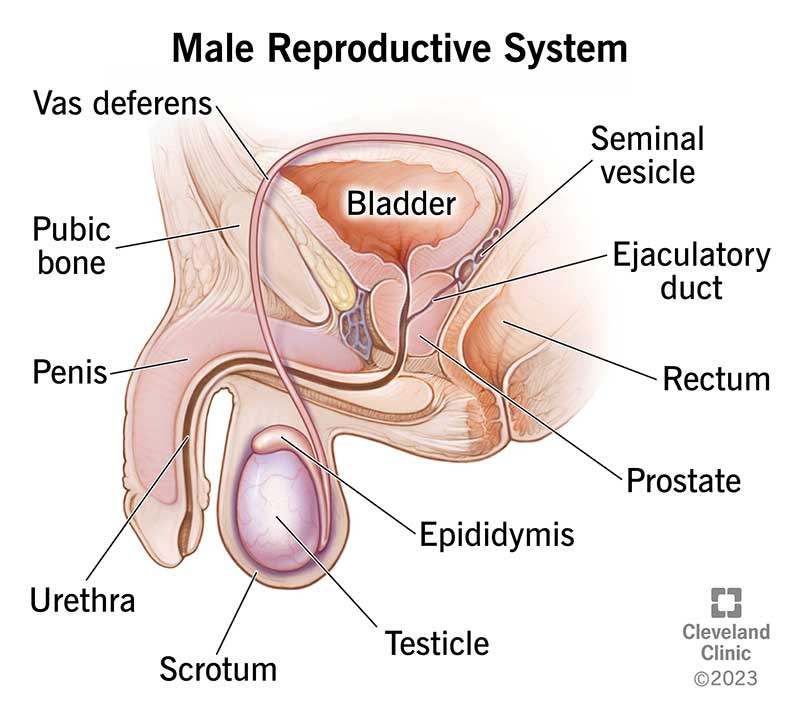Benign Prostatic Hyperplasia: Everything you need to know!
Published Apr 5, 2024 • By Candice Salomé
Benign Prostatic Hyperplasia (BPH), also called prostatic adenoma or benign prostatic enlargement, is characterized by an increase in the size of the prostate.
BPH generally does not cause any symptoms, but the risk of developing symptomatic benign prostatic hyperplasia increases with age.
So, what are the causes and symptoms of benign prostatic hyperplasia? How is it diagnosed? What are the treatments?
We tell you everything in our article!

What is the prostate?
The prostate is a gland located beneath the bladder in the male reproductive system. It produces fluids that are part of semen composition.

Source: Male Reproductive System — Cleveland Clinic
A healthy prostate is about the size of a large walnut. It has a volume ranging from 15 ml to 25 ml. This gland tends to increase in size around the age of forty and continues to grow with age.
The medical term for a prostate that has increased in size is: benign prostatic hyperplasia (BPH).
What is benign prostatic hyperplasia (BPH)?
Benign prostatic hyperplasia is a common condition in older men. Indeed, with age, the prostate becomes too large and hinders urine emission. This excessive growth is also called prostatic adenoma.
The risk of benign prostatic hyperplasia increases with age. Thus, after 60 years, 60% of men suffer from it, and this increases to 90% after 85 years.
It should be noted that BPH does not increase the risk of developing prostate cancer.
What are the symptoms of benign prostatic hyperplasia (BPH)?
When there is benign prostatic hyperplasia (BPH), urinating becomes difficult: urination is slow to start, the flow is weak and intermittent, and urine drops continue to flow for 1 minute or 2, promoting "urinary leakage" post-urination.
After urination, people with BPH feel that the bladder is not completely emptied. The urge to urinate becomes more frequent, both day and night.
Furthermore, men who suffer from BPH are more prone to bladder stones or recurrent urinary tract infections.
What are the possible complications of benign prostatic hyperplasia (BPH)?
A bladder that does not empty properly increases the risk of complications.
Thus, benign prostatic hyperplasia can present short-term and long-term complications:
- Short-term complications such as acute urinary retention, urogenital infections, hematuria (presence of blood in the urine), and acute obstructive renal failure,
- Long-term complications such as chronic bladder retention, bladder stones, and chronic obstructive renal failure.
For some patients, urinary problems related to benign prostatic hyperplasia have negative psychological consequences on their sexuality.
BPH never degenerates into prostate cancer. However, since both pathologies have similar symptoms, even though prostate cancer is often asymptomatic, it is possible to suffer from both diseases simultaneously.
How is BPH diagnosed?
When difficulties urinating or urgent needs are felt and affect the quality of life of individuals, it is important to consult a doctor.
The doctor will ask the patient about the frequency and intensity of the symptoms. Then, proceed with a rectal examination. This medical examination allows for the detection of prostate abnormalities. Thanks to this examination, the doctor can spot changes in size and consistency of the prostate.
In the case of BPH, the prostate is larger but remains soft, and its shape remains the same.
If the doctor detects lumps or hardening, they will schedule further tests to find the cause, such as an ultrasound, radiography, blood tests.
What are the treatments for benign prostatic hyperplasia (BPH)?
The treatment of benign prostatic hyperplasia depends on the severity of the discomfort felt, urinary disorders, and the impact on the patient's quality of life.
Based on this, several options are possible:
- Regular monitoring may be proposed when the discomfort is mild or adequately tolerated, there are no complications, and the bladder empties correctly,
- Medications can be prescribed when the discomfort is moderate or intense; these can help relax the prostate muscles, reduce inflammation, or decrease its size.
- Surgical intervention may be considered when medication is not sufficient or in cases where complications occur (bladder stones, urine retention...).
Overall, the symptoms of BPH tend to remain minor enough not to justify treatment or surgical operation. Only 15% of cases of benign prostatic hyperplasia require medical management to avoid complications.
Is it possible to prevent benign prostatic hyperplasia (BPH)?
It is not really possible to prevent BPH from occurring. However, it is possible to prevent the discomfort and complications it causes. Here's how:
- Urinate as soon as the urge is felt. Indeed, holding it in can tend to irritate the bladder,
- After 7 p.m., it is advised to drink moderately so as not to have to get up at night,
- Certain foods should be avoided such as spicy and salty dishes, alcohol, drinks rich in caffeine... These tend to aggravate the symptoms of BPH,
- In case of a cold, avoid taking medicines containing a decongestant (like pseudoephedrine). These substances make urine emission more difficult.
- Engage in regular physical exercise. Indeed, good muscle tone allows better control of urination urges. However, avoid sports that tend to jostle the bladder such as mountain biking, horseback riding, tennis, etc.
Was this article helpful to you?
Give it a "Like" and share your thoughts and questions with the community in the comments below!
Take care!
Comments
You will also like

What are the dangers associated with the over-the-counter sale of certain medicines?
Dec 19, 2020 • 6 comments

 Facebook
Facebook Twitter
Twitter

